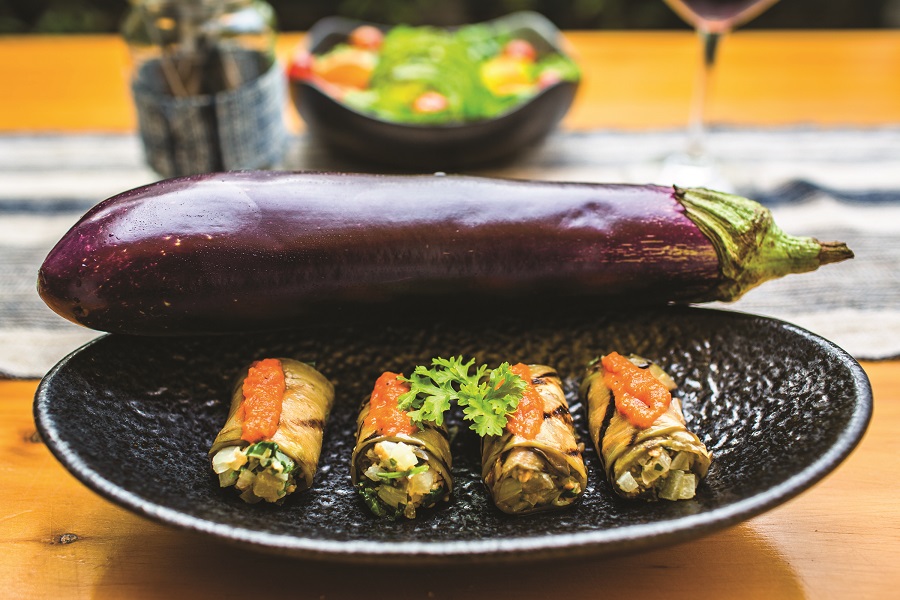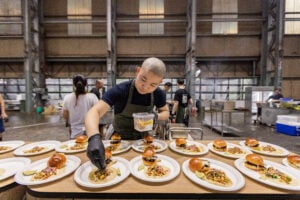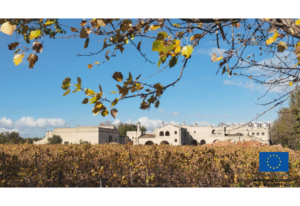Exploring Vietnam’s best vegetarian ingredients
For many, Vietnam is a paradise for vegetarians of all kinds. Restaurants roll out a vegetarian menu for the first and 15th of every month for those looking for a bit of soul purification. Home cooks revel in a huge assortment of fruits and vegetables, changing with the season. And foodies rejoice with all the new vegetarian-as-health-food places that are springing up around the city like mushrooms.
Kim Fay, author of Communion: A Culinary Journey Through Vietnam, recalls what she saw of the country’s love affair with fruits and vegetables. “Vietnam is a country for vegetarians. Not only are salads plentiful, there is a strong tradition of vegetarian cuisine in the Buddhist communities. I love that meals in Vietnam are often followed by cold fresh fruit, rather than dessert. I also love that when I lived in Vietnam, you knew the season by the fruit in the market. As for veggies, I think about the herbs that are used to garnish everything from salads to soups to spring rolls. Even if a dish is deep-fried, it will usually come with some fresh greens to lighten it. I find now that a meal is not complete for me if it isn’t accompanied by some type of fresh greens.”
While the majority of Vietnam’s vegetarians do it for religious reasons, it’s becoming a more vegetarian-friendly culture for expats and travelers. “In my experience, people are not offended if you tell them, ‘I can’t eat this’ or ‘I can’t eat that’,” says Kim. “My sister does not eat beef or pork and the people we met along the way – in private homes and in restaurants – were happy to accommodate that. The one issue vegans might have is with fish sauce, which is essential to the cuisine. But many Buddhist dishes use soy sauce rather than fish sauce, so you’re sure to find something you can eat. And when you’re in a pinch, head for a banh mi stand and buy a baguette – you can never go wrong with that. Bottom line: Vietnamese food is very flexible!”
Oi met some of the city’s top chefs to ask them about their favorite vegetarian ingredients and how to prepare them.
Lotus (Stems, seeds, roots and leaves)
Vietnamese: Sen (ngo, hat, cu, la)
Nutritional value: According to Auburn University (USA), lotus seeds can be ground and used as flour, the roots cooked like sweet potatoes and the leaves used as spinach. The stems have antioxidant properties and are a rich source of calcium, iron and fiber.
Uses: Almost every part of the lotus can be used in cooking. In Vietnam, the seeds can be eaten as a snack, straight from the flower or steeped in a sugar syrup and then dried, or are cooked into desserts or glutinous rice. The stems can be found raw in salads or stir-fried or pickled. The leaves can be used to infuse flavor into fried rice. Even lotus root can be used for stocks and salads.
Tuan, owner of Tuan and Tu’s restaurant, recommends using lotus seeds in stews, as they need time to soften. And Nguyen, formerly at New World Saigon Hotel’s Parkview Restaurant, says preparing the stems for the restaurant’s Lotus Stem Salad is simple (with crispy tofu replacing the more traditional boiled shrimp and pork). “Just cut off both ends of the stalks and rinse. Use your fingers or a knife to peel off the outer skin before soaking in a diluted salt water bath for 15-20 minutes. Most people throw away the part closer to the root and just use the stem, but you can keep it for a stir-fry because that part is actually a bit sweeter. For lotus roots, instead of salt water, soak them in ice water with a few drops of lemon juice to keep them fresh,
crunchy and tasty.”
Purple Eggplant (Ca tim)
Nutritional value: Eggplants and other purple plant foods, such as blueberries and grapes, provide phytochemicals found in the skin of the eggplant, and have been linked to protecting fats found in brain cell membranes. They are also low in calories and contain other compounds that promote good health, possibly even helping to prevent cancer and lowering cholesterol.
Uses: “Eggplants are extremely versatile as they can be used in Asian and Western dishes and they’re easy to find cheaply here in Vietnam,” says Thanh Yen, co-owner of Prem Bistro & Café, a vegetarian restaurant. Spongy, with a pleasantly bitter taste, purple eggplants find their way into Vietnamese stews, soups and stir-fries, or are simply grilled and topped with scallion oil. Prem’s uses eggplant slices (lengthwise), salted and pan-fried with olive oil to wrap around a filling of onion, spinach and ground cashew nuts, topped with a lightly seasoned tomato puree. “For Vietnamese, the word ‘vegetarian’ has a negative connotation. Vegetarian dishes typically include a lot of chemicals, or are made from flour and molded into fake meat. Because Vietnamese are vegetarian mostly for religious reasons, they don’t really care whether what they’re eating is good for them or not. But we’re seeing many younger Vietnamese take on vegetarianism as a lifestyle, to be more healthy,” says co-owner Ha Le.
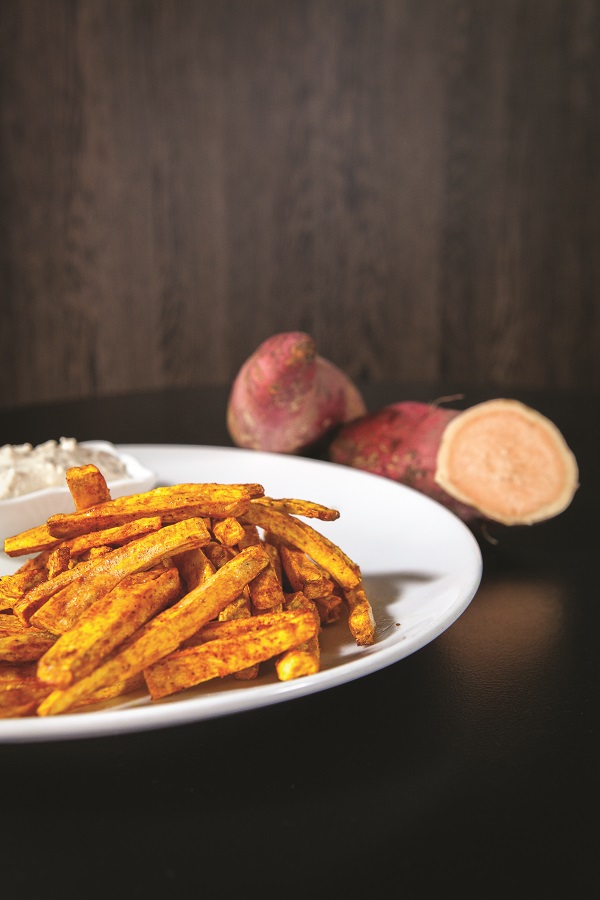
Sweet potato – air fried chips
Sweet Potato (Khoai lang nuong)
Nutritional value: Known as one of the healthiest vegetables around, a medium sized sweet potato contains more than your daily requirement of vitamin A, nearly a third the vitamin C you need, almost 15 percent of your daily dietary fiber intake and 10 percent of the necessary potassium. Sweet potatoes also contain antioxidants and have anti-inflammatory properties.
Uses: The Vietnamese use both the leaves and tubers in cooking. Leaves can be stir-fried and the tuber is often seen deep-fried as a snack sold in small glass cases on the side of the road or stewed in curries and even in desserts. Bodybuilder and restaurateur Ben Dell, who owns Ben Style, says sweet potatoes are an excellent source of carbohydrates and are slow burning so they don’t raise your blood sugar, important when you’re looking to lose fat. He also makes a healthy version of sweet potato chips. “They’re a little bit tougher [than regular white potatoes], but are great for people who want to stay healthy. Because they’re tough and hard, soak them in water for 24 hours to soften them up. That also keeps them from drying out when cooking. Cut them into wedges and brush them with olive oil or a non-fat spray before putting them in a convection oven. Just add a bit of allspice for flavor. No need to go to McDonald’s!”
Yogurt and Cheese (yaourt or sua chua and pho-mai)
Nutritional value: Not a carbohydrate, protein or fat, natural yogurt is nonetheless plentiful in lactose, proteinrich and abundant in healthy fatty acids. Vitamins and minerals naturally found in milk are better assimilated in the form of yogurt, and the healthy bacteria aid in the production of vitamins and help the bloodstream better absorb calcium. Cheese is a source of many essential nutrients, including highquality protein, and can be part of a healthy diet, especially when paired with lower-calorie foods.
Uses: The Vietnamese tend to eat sweetened yogurt more as a snack than in cooking. Yogurt frozen in small containers or little bags are a popular after-school treat. It can also be made at home easily and cheaply, using one can of sweetened condensed milk, mixed with two cans of hot water and one can of lukewarm water. A starter culture (for instance, a small container of storebought yogurt) is added, stirred and then refrigerated. For thicker yogurt, use fresh milk instead of water.
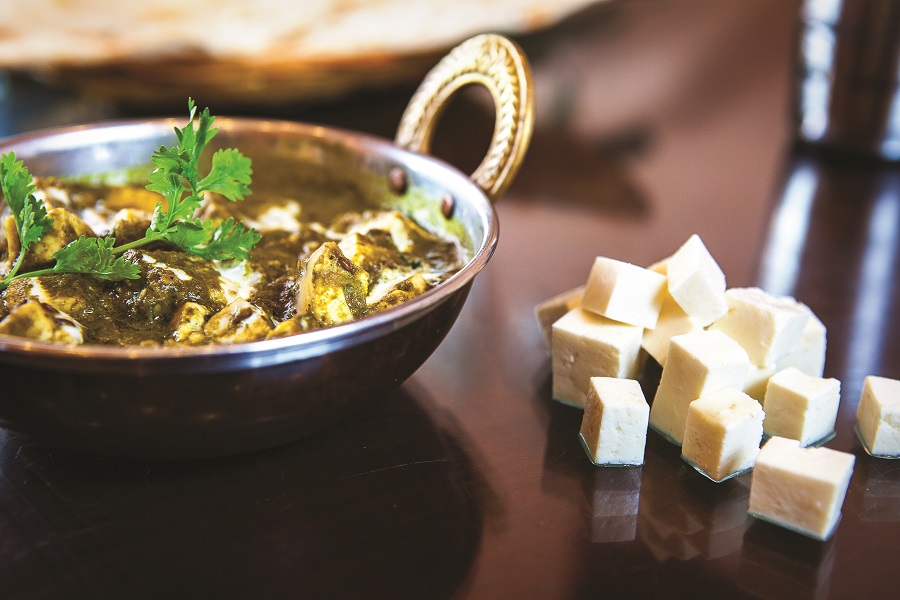
Paneer (cheese)
Robin Deepu, owner of Baba’s Kitchen, says in his native India, yogurt isn’t a breakfast food but is mainly used in cooking, as a base for spices used in marinades, or used in lassi, a refreshing yogurt drink. The key to good yogurt is boiling the milk over a longer period of time, as high heat will shorten the process and make the yogurt watery. His restaurant also makes paneer, a chewy, milky, fresh cheese (no aging required) and one of the easiest cheeses to make at home. “You just take fresh milk and boil it, then add a little vinegar. Once it thickens, tie it up with a cloth [to strain] and then press it with a weight on top,” says Robin. Because paneer doesn’t melt the way cheddar or mozzarella does, it keeps a tofu-like consistency in soups or curry, like Robin’s Palak Paneer, cubes of paneer simmered in a puree of spinach, tomatoes, garlic and onions and flavored with ginger, garam masala, turmeric, chili and coriander power and fenugreek.

